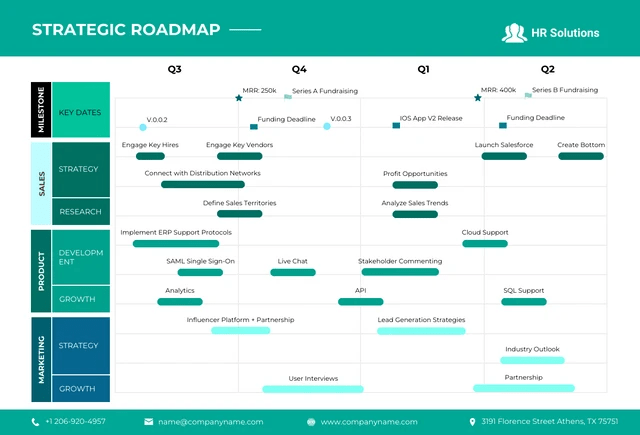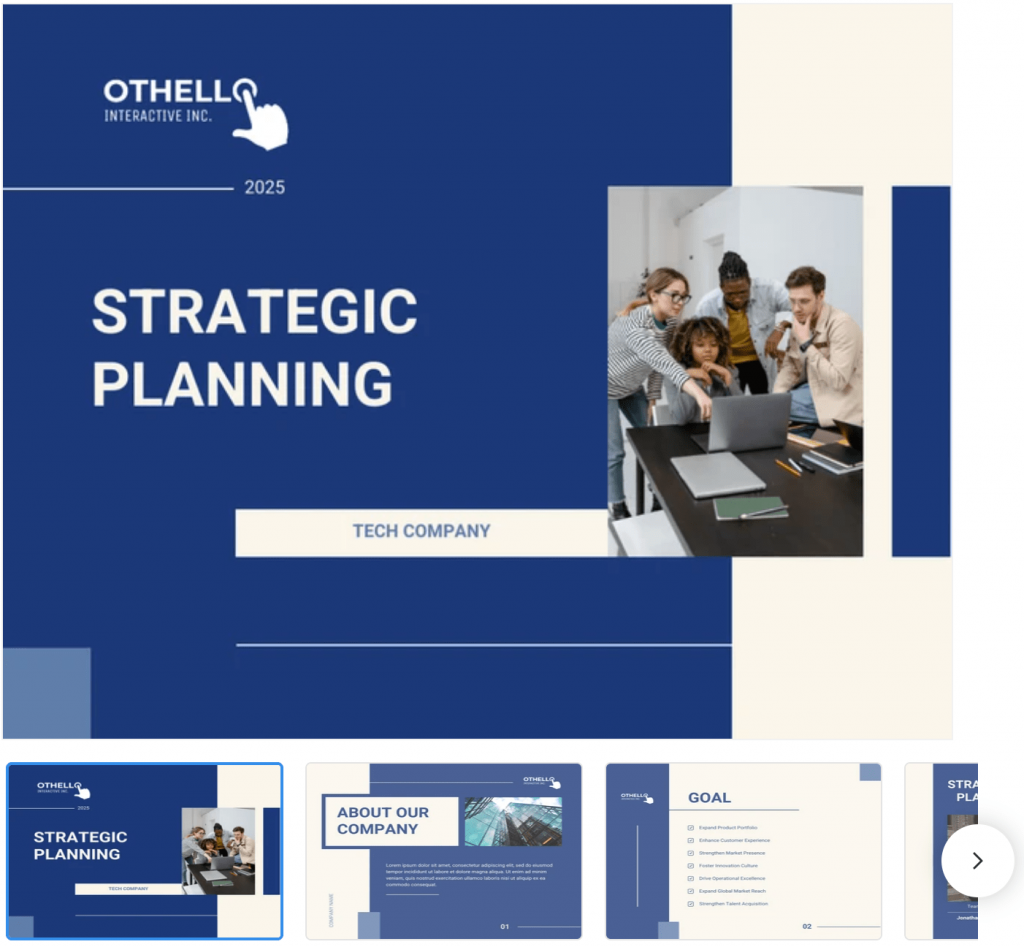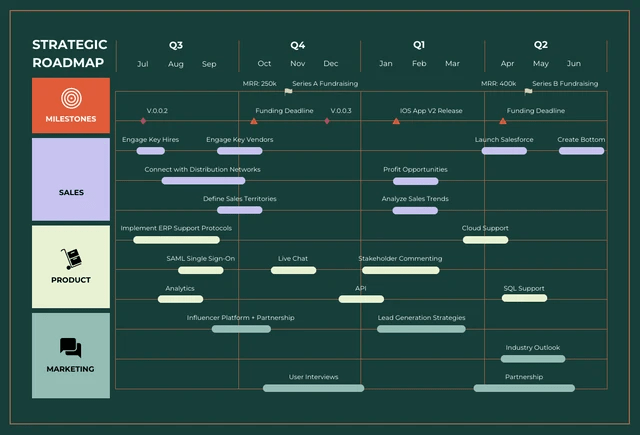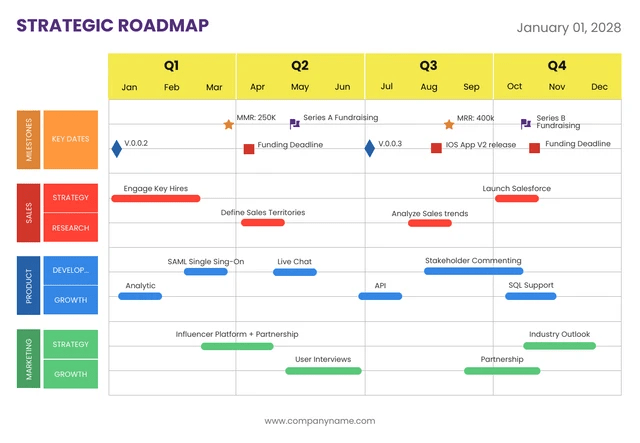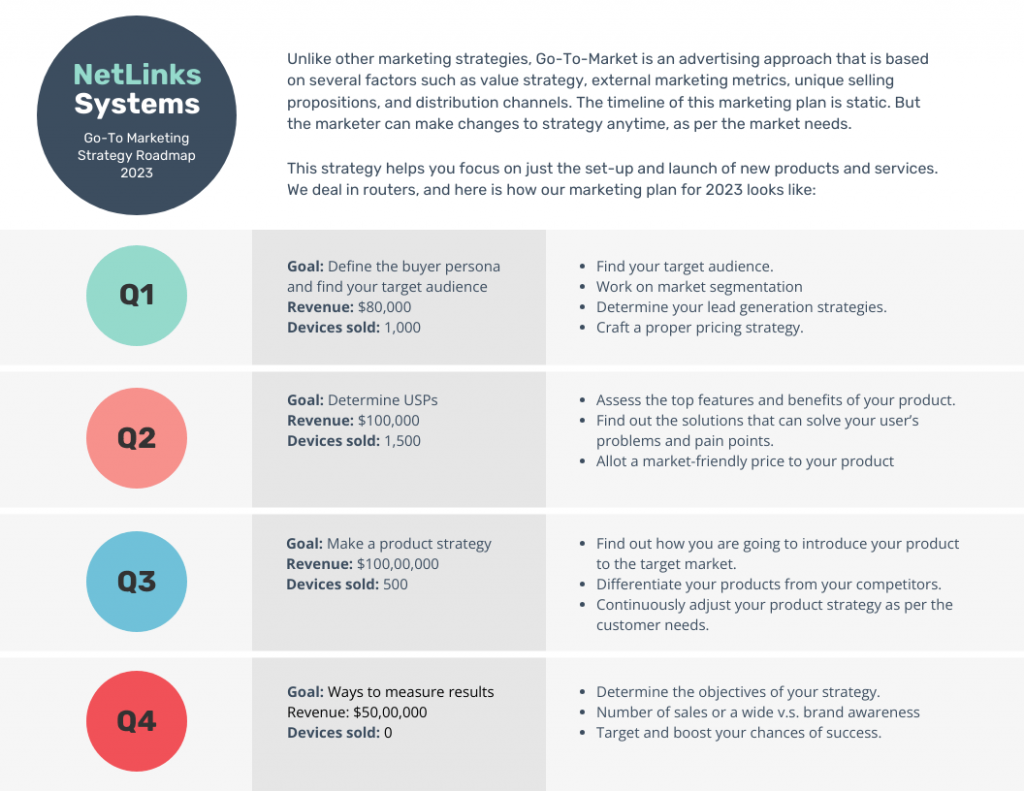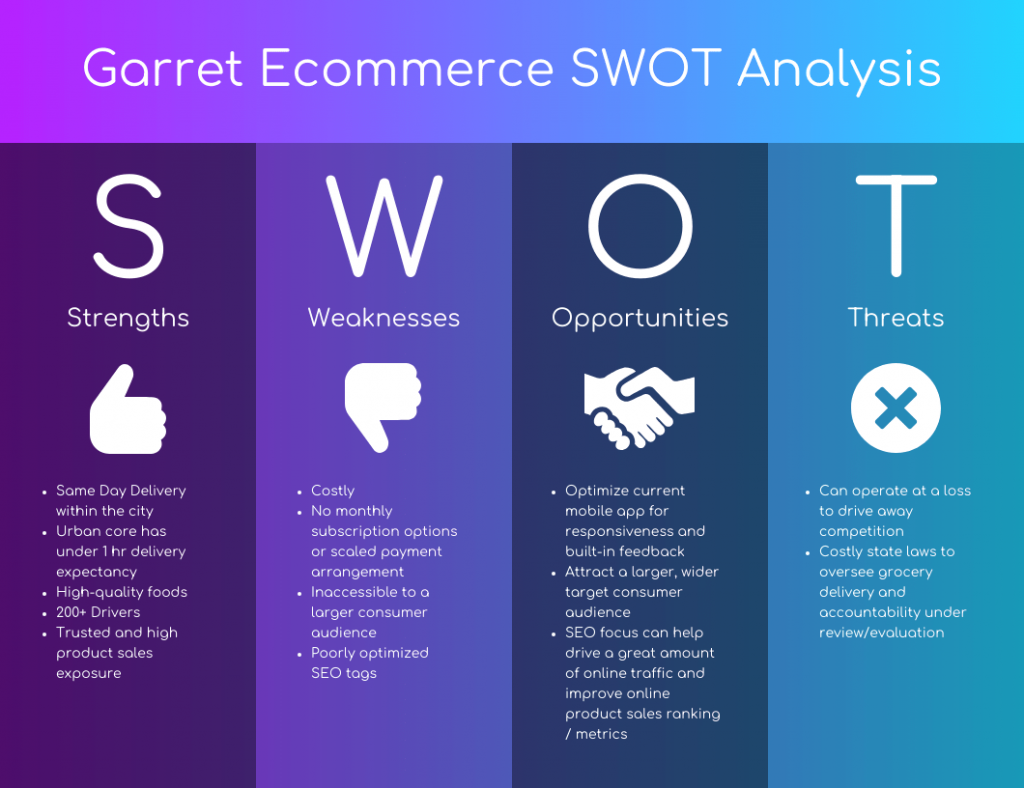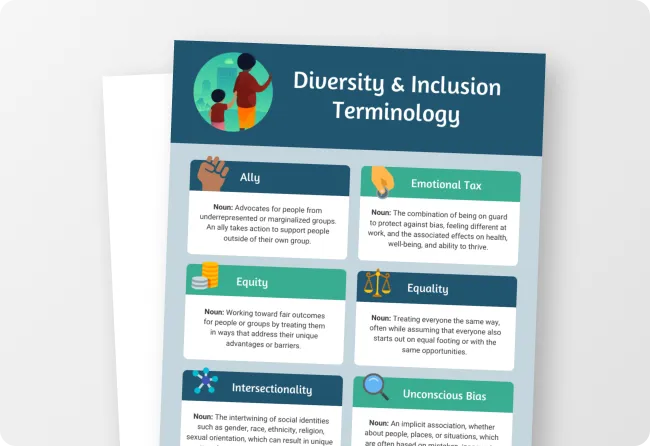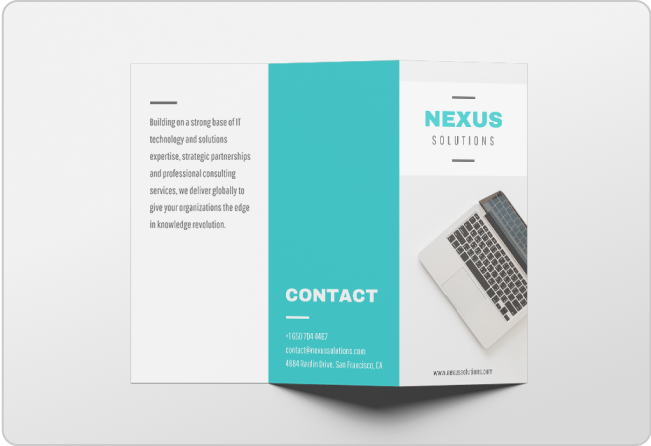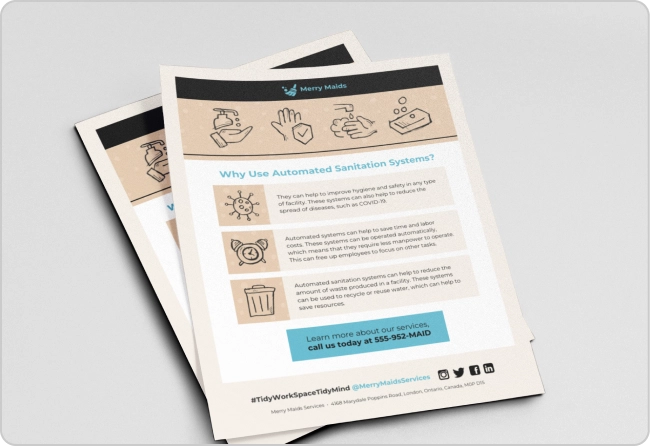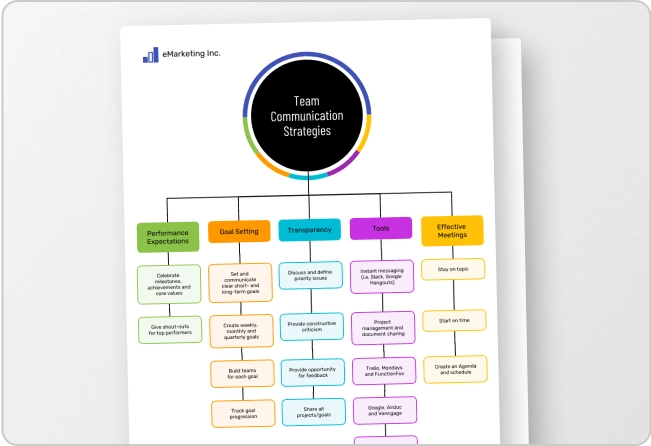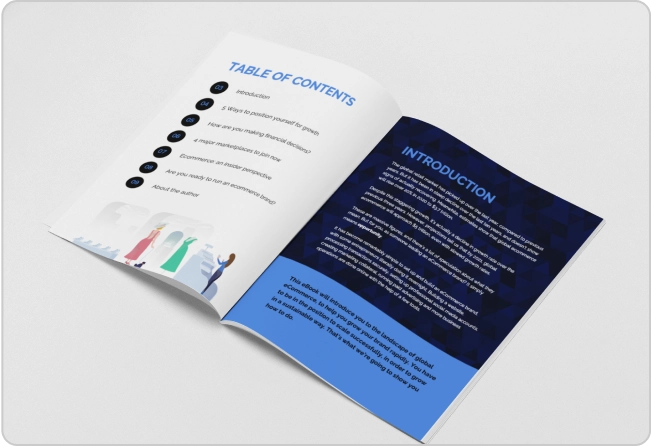
You probably have experienced this before: your strategy makes a lot of sense on paper. Yet, your team struggles to understand how day-to-day work connects to the bigger organizational goals.
That disconnect usually comes from not having a strategic roadmap that sets priorities in a clear, practical sequence.
This blog walks you through what a strategic roadmap is, how teams use it to stay aligned and where you can adapt proven roadmap templates in Venngage to turn your long-term vision into a plan you can actually follow.
What is a strategic roadmap?
A strategic roadmap is a high-level visual plan that links your long-term goals to the key outcomes and initiatives required to achieve them. It shows what you will pursue, why it matters and how priorities will progress over time. It functions as an evolving communication tool for organizational alignment.
Here’s an example of a strategic roadmap visual plan from a SaaS startup that has different initiatives planned across various functions:
Think of your strategy as the destination on a map and your strategic roadmap as the best route you’ll socially commit to. Without this roadmap, you risk running lots of activities without knowing how they connect to long-term goals or how your team’s daily work moves the needle.
A well-constructed strategic roadmap includes clarified objectives, major initiatives and rough timeframes. It doesn’t become a detailed project plan filled with every task and deadline.
But if you skip the roadmap and jump straight into execution, you end up with scattered efforts, misaligned teams and wasted capacity.
If you want to visualize your strategy even further, check out our blog on strategy infographics for simple, practical ways to bring your ideas to life.
Strategic roadmap vs. strategic plan
A strategic plan typically outlines your organization’s long-term direction, sets broad goals, identifies major business initiatives and communicates the means you’ll use to get where you want to be.
A strategic plan is typically a text-heavy document that reads like a detailed guide:
If you want more specific inspiration, our collection of strategic plan examples is a great starting point for building your own.
In contrast, a strategic roadmap zooms in on the “what” and the “why” of those goals.
According to Chuen Seet, co-founder of Jibility:
A strategy roadmap describes the what and the why. An execution plan describes the how.
Here’s what this looks like in practice: your strategic plan may declare a goal to expand into new markets, increase recurring revenue by 40% within five years or improve customer retention.
The strategic roadmap then lays out key goals (e.g., establish two new regional sales hubs, launch a partnership program and reduce churn by 15%) and presents them in a logical order over quarters or years.
The roadmap doesn’t jump into specific details or the day-by-day project deliverables. In that sense, a strategy roadmap is not a visual Gantt chart of activities with start dates and end dates.
When an organization treats its roadmap like a project plan, senior leadership and teams lose sight of strategic intent. At the same time, relying solely on the strategic plan without a roadmap often results in ambitious goals with no clear signal on what must happen first and why.
A strategic plan explains the long-term direction and the reasoning behind your goals; a roadmap turns those goals into a time-bound visual everyone can act on:
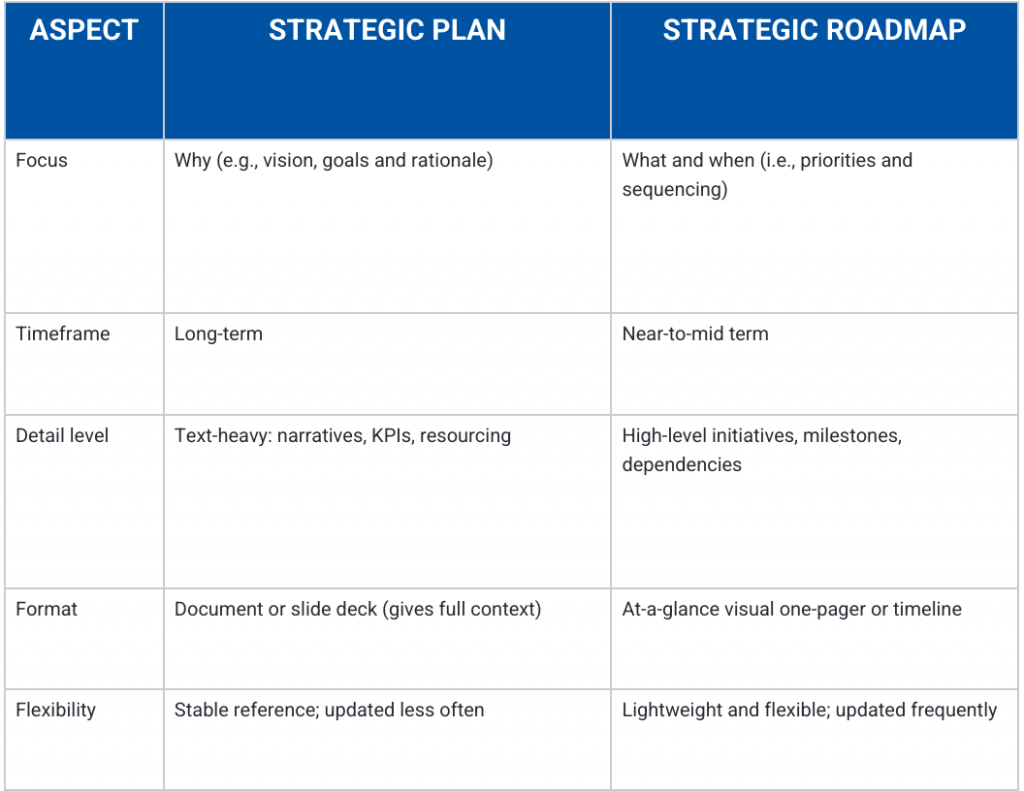
Together they work: use the strategic plan to set direction and reasoning and the roadmap to translate that direction into priorities so teams can execute with clarity.
Why organizations need a strategic roadmap
Most teams have big goals, but turning those goals into required action often feels messy. A strategic roadmap bridges that gap by giving everyone a simple, shared view of what’s most important and when.
Here’s what a clear roadmap makes possible:
1. Align stakeholders around the same outcomes
Senior leaders, managers and ICs often have different interpretations of the same strategy. A roadmap removes ambiguity by presenting agreed-upon priorities in a single visual reference. In one of their blogs, the Aha team notes:
Building and sharing a strategy roadmap clarifies what you are working toward. It is an excellent tool for aligning teams around shared objectives because it gives valuable context about how efforts tie to impact.
For example, this strategic roadmap template is a great fit for a SaaS or tech startup that needs a clear, visual way to align teams and stakeholders around shared project goals:
2. Clarify priorities before execution begins
Many organisations set ambitious goals but fail to articulate which initiatives bring about the best results. Roadmaps give companies a structured way to identify the sequence of high-value initiatives instead of spreading resources across too many directions at once.
A strategic roadmap is a visual guide connecting vision, goals and initiatives over time.
From the Businessmap blog
This strategic roadmap template comes with a clear, structured view of which high-impact initiatives should come first.
3. Make work visible across functions
Visibility improves coordination. When engineering, product, marketing and operations see the same roadmap, they understand where their work fits and where dependencies exist. This prevents teams from running their own version of the strategy.
Here’s a great example of a strategic roadmap template that makes cross-functional work visible and helps teams see where their tasks fit or how they depend on one another.
4. Support communication with boards and investors
A roadmap helps leadership communicate long-term direction without presenting a rigid plan. Investors respond well to clarity of thinking, not bloated project lists. A roadmap shows high-level intent and sequencing, which signals operational discipline.
This visual business roadmap template is a perfect tool for a company’s leadership to present long-term direction to boards and investors:
5. Maintain flexibility as conditions change
Markets shift and customer needs evolve. A roadmap is adaptable because it focuses on outcomes rather than fixed tasks. You can update it during quarterly or biannual reviews without rebuilding your entire planning system.
If you want to present your roadmap in a format that is easy to digest during leadership meetings, consider using a Venngage roadmap template. It helps you communicate priorities clearly and avoids the clutter that often appears when teams build visuals from scratch.
Here’s a quarterly strategy roadmap template that’s perfect for keeping things flexible and outcome-focused in the marketing department:
Components of a strategic roadmap
Here are the seven essential elements you’ll need for a robust strategic roadmap. Each relates clearly back to your overarching strategy and creates a framework you can communicate and act upon.
1. Strategic objectives
These are the “north star” outcomes your organization commits to. For example, your strategic objectives might include increasing annual recurring revenue by 25% or entering two new markets in 18 months. These objectives define what you want to achieve and why it matters.
2. Initiatives
These major programmes or themes channel effort toward your objectives. For instance, building a partner ecosystem or launching a major product upgrade.
The strategic roadmap breaks down those objectives into actionable stages, guiding the implementation process and ensuring alignment across the organization.
From the Planview blog
3. Actions
These are less granular tasks but still substantive steps required by each initiative such as finalising partner contracts, redesigning onboarding flows or rolling out training for sales. They turn initiatives into actionable clusters.
4. Timelines
This defines when key items will take place, for example, Q3 2026 for pilot launch, Q1 2027 for full rollout. Roadmaps use time buckets (quarters or halves), rather than exact dates, to keep them strategic yet directional.
5. Milestones
Milestones mark significant points of progress, for example, achieving a 50% partner pipeline, closing the first international deal or reaching customer churn under 5%. They give your team visible checkpoints without turning the roadmap into a detailed Gantt chart.
6. Dependencies
Dependencies identify how work streams rely on each other. For instance, the product upgrade must be complete before the partner sales launch or data migration must finish before the analytics dashboard rollout. A roadmap that ignores dependencies risks bottlenecks.
7. Risks
A roadmap without risks is optimistic to a fault. You need to map out potential obstacles (skills gaps, regulatory changes, tech failures) and consider mitigation options. Including risks strengthens the credibility of the roadmap with leadership and investors alike.
How to build a strategic roadmap (Step‑by‑step)
Follow these six steps to turn strategy into a clear, shareable roadmap you can use in planning, hiring and investor conversations. Every step links back to measurable objectives so you avoid a feature list.
1. Understand your current position through situational analysis
Run a focused diagnostic of internal strengths and weaknesses and the external factors that affect your market. Use SWOT analysis to capture internal gaps and PESTLE analysis to record regulatory, economic or technology trends.
Put findings into a concise one-page brief you can share with leadership and product teams. This step uncovers where to concentrate effort and where to stop investing.
Produce a four-column table summarizing the company’s strengths, weaknesses, opportunities and threats. Use the strengths and weaknesses columns to highlight internal capabilities.
Use the opportunities and threats columns to show external forces. Then, use this table to justify one or two priority initiatives. Here’s an example:
2. Define strategic objectives linked to your vision
Write three to five objectives that reflect your long-term vision. Pair each objective with two to four measurable key results. Keep objectives outcome-focused and timeboxed to a planning cycle.
Use OKRs to force clarity on success criteria and to prevent vague ambitions from bleeding into the roadmap. Share these objectives with stakeholders for agreement before you build initiatives.
For instance, the objective can be to grow recurring revenue by improving retention. Or, the key results can be to reduce churn for the core cohort and increase expansion revenue per account. Use these results to score and select initiatives.
3. Evaluate capabilities and resources
Inventory your people, processes and technology. Score delivery capacity against each objective on a simple RAG scale. Identify skill gaps and hard constraints such as budget or compliance cycles. Use this assessment to set a realistic scope for initiatives.
4. Develop initiatives and prioritize them
Translate objectives into initiatives. Give each initiative a single sentence outcome statement and a lead owner. Prioritise with a simple value versus effort framework or an impact-risk matrix. Remove initiatives that do not link directly to an objective. Practitioners warn against treating roadmaps like feature lists. Keep every item tied to an outcome and a metric.
5. Set timelines, milestones and KPIs
Place initiatives into broad time buckets such as quarter 1, quarter 2 or later this year. Assign two to three milestones per initiative and a primary KPI for each milestone. Use time buckets rather than fixed dates to preserve strategic flexibility. Track progress at monthly or quarterly reviews and use the KPIs to decide whether to accelerate, pause or stop work.
6. Review and refine the roadmap regularly
Schedule formal roadmap reviews at least every quarter. Reassess objectives, re-score initiatives and record new dependencies or risks. Use reviews to update stakeholders and to convert roadmap items into execution plans when capacity and timing allow. Roadmaps must evolve as conditions change.
Bring the roadmap into a visual that you can present in one slide. Use a Venngage roadmap template to display objectives, initiatives, time buckets and KPIs side by side. This keeps your narrative tight and your decision points visible during planning meetings.
Best practices and common pitfalls
You get more value from your roadmap when it is clear, practical and easy for teams to use in real planning conversations. These practices help you maintain that standard.
1. Keep the roadmap simple and direct
Use plain language, avoid jargon and focus on outcomes. A roadmap works when anyone on your team can read it and understand the strategic intent without a long explanation.
2. Tie every initiative to a strategic objective
If an initiative does not support an objective, remove it. This prevents scattered effort and keeps leadership aligned on where resources should go first.
3. Involve stakeholders early
Invite product, engineering, sales and operations leaders into the shaping process. This builds shared ownership and reduces friction during quarterly planning or budgeting.
4. Use time ranges instead of hard dates
Categorise work into near-term, mid-term and later periods. This keeps the roadmap strategic and avoids the pressure to treat it like a delivery schedule.
5. Revisit the roadmap regularly
Use quarterly reviews to refine scope, add new insights and adjust sequencing. Strategy evolves and the roadmap should evolve with it.
Pitfalls to avoids
1. Don’t turn the roadmap into a feature list
Feature dumps dilute strategic focus. Keep your roadmap centred on outcomes rather than task-level detail.
2. Avoid presenting the roadmap as fixed commitments
A roadmap is a strategic guide, not a contract. Avoid promising specific delivery dates or outputs before capacity and feasibility are validated.
3. Don’t ignore dependencies and risks
Missing these factors creates unrealistic timelines and surprise bottlenecks. Identify them early and flag them clearly.
4. Don’t overload the roadmap with too many priorities
A crowded roadmap shows a lack of focus. Limit initiatives to the ones that truly move the needle and place the rest in a backlog for future cycles.
Pro-tip: If you want to present these practices visually in a clean one-page format, consider using a Venngage process mapping or flowchart template. It helps you communicate expectations clearly during planning workshops and leadership reviews.
Strategic roadmapping tools and templates
The right tools don’t just make your roadmap look better; they make it easier to think clearly. Visual builders like the Venngage AI Roadmap Generator help teams translate messy, unstructured ideas into organized, strategic narratives in minutes.
Instead of wrestling with slides or spreadsheets, you can generate a coherent roadmap draft automatically and refine it with your team.
For those who prefer starting from proven structures, Venngage’s Strategic Roadmap Templates offer plug-and-play layouts designed for product, marketing, operations and cross-functional planning.

Together, these tools give organizations a practical way to standardize their planning process, reduce back-and-forth and create roadmaps that are both visually engaging and strategically rigorous.
Connecting roadmaps to the broader strategic planning process
Strategic planning usually starts with mission and vision, moves into tools like SWOT or PESTLE to understand the landscape and ends with goals, big initiatives and the metrics to track progress. Whether a team uses a classic framework or its own process, the result is a detailed plan that explains the “why” and “how” behind key decisions.
A strategic roadmap takes that plan and turns it into something people can act on. It pulls out the key objectives, initiatives, dependencies and timelines and shows them in a simple, time-bound visual. The plan offers depth; the roadmap offers clarity.
Practical use cases of strategic roadmaps
1. Obtain investor buy-in
Use a high-level roadmap to show milestones, expected outcomes and the sequence of bets you will take. Investors look for clarity on timing and impact. Keep the slide concise and tie milestones to revenue or traction metrics.
2. Product roadmapping
Use a strategic product roadmap to link feature groups and epics to business goals. This keeps product decisions aligned with growth targets and helps cross-functional teams plan capacity and launch windows.
3. Guide digital transformation
Use a transformation roadmap to sequence capability building, technology adoption and process change. A clear roadmap prevents scattered IT projects and shows how each investment moves the business toward measurable outcomes.
4. Capability-based planning at scale
Use capability maps and a strategic roadmap to prioritise which business capabilities to build or improve first. This approach helps you allocate budget across initiatives that deliver the most value for the enterprise.
Bridging vision and execution
Most businesses fail because they struggle to execute their strategies effectively. A strategic roadmap fixes that by turning ambition into a series of actionable decisions, milestones and outcomes that your teams can actually act on.
In a market where priorities shift quickly, a roadmap gives your strategy the structure it needs. It also lets you course-correct your initiatives when market conditions change while keeping the broader goals in sight. And because it’s visual and easy to share, it becomes a tool for alignment.
If you want to turn intent into momentum, start building your own roadmap. Use Venngage’s AI Roadmap Generator or explore the full library of Venngage Roadmap Templates to turn your strategy into action.





























